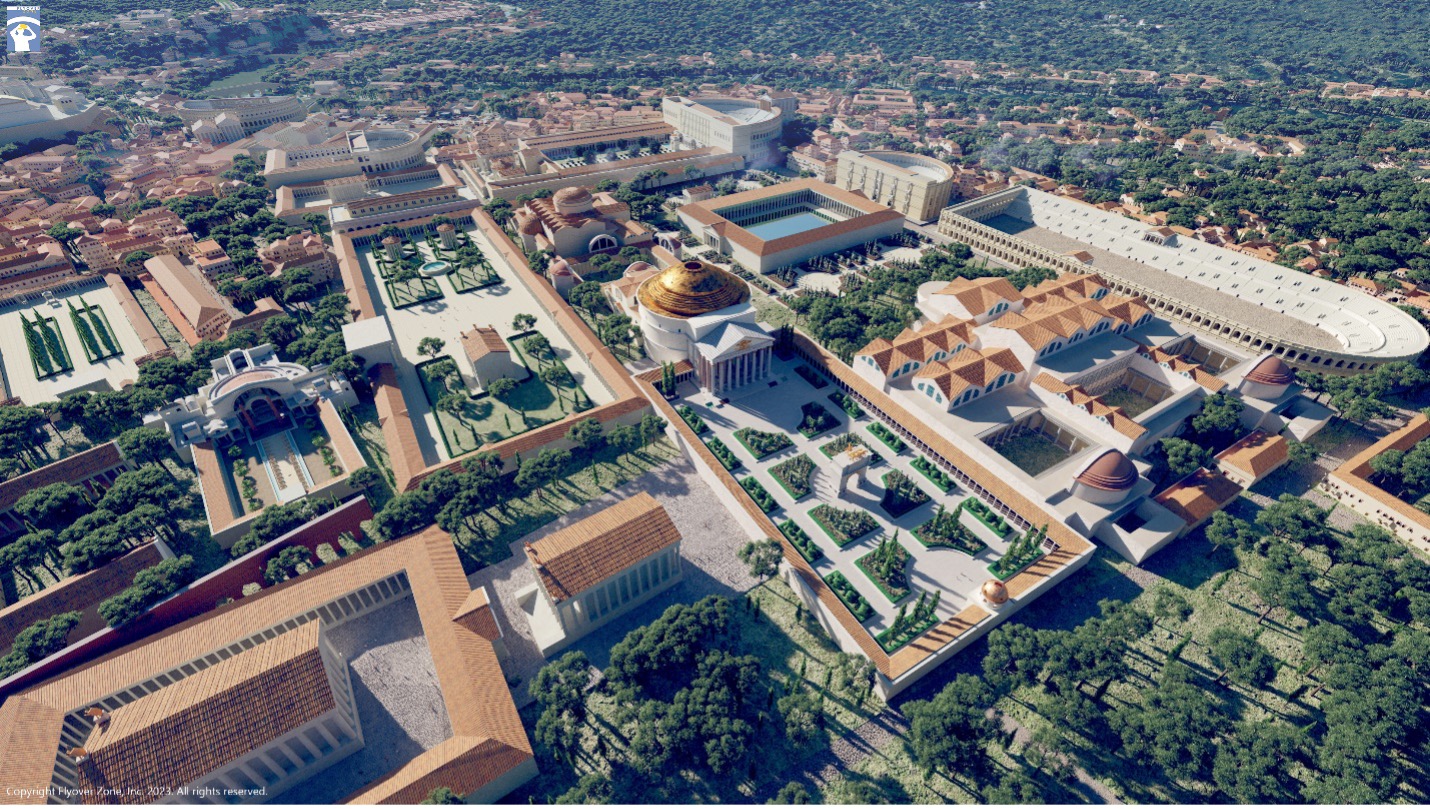NEW DIGITAL MODEL OF ANCIENT ROME LAUNCHES NOVEMBER 8, OFFERING
VIRTUAL TIME-AND-SPACE TRAVEL TO THE ENTIRE CAPITAL OF THE ROMAN EMPIRE
*****
3D DIGITAL TOUR OFFERING A FLIGHT OVER THE ANCIENT CITY
DEBUTS AS PART OF THE LAUNCH
***
Model Supports a Variety of Uses Ranging from Academic Study to Virtual Tourism
BLOOMINGTON, IN, NOVEMBER 8, 2023 — Flyover Zone, a leading educational technology company founded by archaeologist and digital humanist Dr. Bernard Frischer, today launched version 4.0 of Rome Reborn™, its widely acclaimed 3D reconstruction of the entire city of ancient Rome. A landmark project in the history of digital art and education, revised and refined over decades as the field has evolved, the meticulous, panoramic reconstruction is being made accessible to the public starting today through the Flyover Zone virtual tour Rome Reborn: Flight over Ancient Rome, available on the company’s streaming platform, Yorescape™. Flyover Zone also offers thirteen other virtual tours on Yorescape (www.yorescape.com), including visits to the Acropolis in Athens and the Tomb of Ramesses VI in Egypt. To celebrate the launch event, the company is offering a free, one-week trial subscription to Yorescape at https://yorescape.page.link/rome.
Bernard Frischer said, “Yorescape Rome Reborn 4.0 is the culmination of more than twenty-seven years of collaborative international work in using digital tools to research cultural history and bring it to life. By making the Rome model available through the virtual tour called Flight over Ancient Rome, we hope to make it easy and enjoyable for people to learn about the ancient world city and its cultural heritage. Teachers can use this and other tours on Yorescape to take their students on virtual field trips to the cultures they are studying. Armchair travelers can explore great heritage sites without having to leave home. Yorescape can help travelers to prepare for a trip to Rome, get more out of a trip by using it once they have arrived, and keep their memories alive once they return home. Our goal is not to replace real-world tourism but to enhance it.”
Rick Steves, host of Rick Steves’ Europe on PBS, said, “I’m so thankful, as we produced our new public television art series, for Yorescape by Flyover Zone—a great app for virtual tourism. Thanks to their impressive animation, we were able to take our viewers back 2000 years for a vivid glide over a virtual ancient Rome. Yorescape can help travelers enjoy such a virtual experience to cultural heritage sites around the world.”
Rome Reborn 4.0 is the latest version of an urban model that has been in development under Frischer’s direction since 1996. From the start, Rome Reborn was an international collaborative initiative, bringing together experts on Roman archaeology, computer graphics, and Virtual Reality design. Version 1.0 appeared in 2007, 2.0 in 2008, and 3.0 in 2018. Video fly-throughs of these earlier versions have been seen by millions of people around the world.
Like the earlier versions, Rome Reborn 4.0 presents the city as it might have appeared at the peak of its development in the year 320 CE, just before the capital was moved to Constantinople. Scholars believe that the population was about one million, making Rome by far the most populous city in Europe prior to the nineteenth century. Fourth century Romans lived and worked in approximately 7,000 buildings spread over 13.6 square kilometers (5.3 square miles) within the late-antique Aurelian Walls, all of which is brought into dynamic visual splendor in Rome Reborn: Flight Over Ancient Rome. The urban reconstruction of ancient Rome is as scientifically accurate as the fragmentary surviving evidence allows. As new discoveries and new interpretations of the evidence appear, the Flyover Zone team continually modifies Rome Reborn to ensure that it offers a reliable and complete visualization of the city.
Rome Reborn: Flight Over Ancient Rome gives a bird’s-eye view of the entire digital model, allowing the user to soar over the ancient landmarks and listen to expert descriptions of 43 monuments, temples, buildings, and sites. Six “Time Warps” spread around the city allow comparisons of the view today with the views from the same vantage point in antiquity.
Creating Rome Reborn
Frischer had the idea to create Rome Reborn in 1974 when he was a Rome Prize Fellow in Classics at the American Academy in Rome. In October of that year, the Academy took the Fellows to see an impressive physical model of ancient Rome in the Museum of Roman Civilization. The experience sparked Frischer’s imagination, and a few years later, at a private conference held at Apple Computer, he presented the idea of digitizing the model, to be used as the main visual resource for a virtual tour of the ancient city.
Frischer launched the project by recruiting an international advisory council, assembled at a meeting held at the American Academy in Rome in 1996. From 2002 to 2004 he directed the team, led by engineer Gabriele Guidi (then at the Politecnico di Milano and now at Indiana University) that scanned the physical model in the Museum of Roman Civilization. The scanned data produced the first Rome Reborn, which Walter Veltroni, Rome’s mayor, and Frischer launched at a press conference in Rome’s City Hall in 2007. In version 2.0, released in 2008, the scan data from the physical model were replaced with more detailed, born-digital representations of the city’s architecture. Version 3.0 followed in 2018.
Rome Reborn was ripe for a fourth iteration in 2023 as a result of the development of advanced computer graphics, which made it possible to achieve a higher degree of photorealism. In addition, recent archaeological discoveries enabled the Flyover team to enrich the urban database with new and updated recreations of important monuments in the city that had been absent from earlier versions. Examples include the Baths of Caracalla, the temples on the Capitoline Hill, and the structures in the theater district like the Stadium of Domitian (modern-day Piazza Navona) and the theaters of Balbus, Marcellus, and Pompey the Great.
About Flyover Zone
Among the scientific advisors who collaborated on the Rome model released at the launch are:
● Engineer Heinz Beste, German Archaeological Institute, Rome
● Amanda Claridge, Professor of Roman Archaeology at Royal Holloway, University of London (deceased, May 5, 2022).
● Dr. Fulvio Cairoli Giuliani, Professor Emeritus of Building Survey and Analysis at the Sapienza University of Rome.
● Dr. Diane Favro, Professor Emerita of Architectural History, UCLA School of Architecture
● Dr. Paolo Liverani, Professor for the Topography of Ancient Italy at the University of Florence. He is also the Chair of the Department of History, Archaeology, Geography, Fine and Performing Arts at the University of Florence.
● Dr. Alberto Prieto, Adjunct Professor of Roman Archaeology at the Rome Campus of Loyola University Chicago.
● Dr. C. Brian Rose, Professor of Archaeology at the University of Pennsylvania
● Dr. Russell Scott, Professor Emeritus of Classics, Bryn Mawr College
● Dr. Barry Strauss, Bryce and Edith M. Mowmar Professor in Humanistic Studies at Cornell University
● Dr. Pier Luigi Tucci, independent scholar specializing in Roman Topography
● Dr. Mark Wilson-Jones, Senior Lecture in the Department of Architecture and Civil Engineering, University of Bath
Day-to-day activities of Flyover Zone are overseen by CEO Nathanael Tavares. He received his B.S. in Computer Science at Indiana University and is currently a student in the Executive MBA at Indiana’s Kelley School of Business. Jeremiah Stevens is the company’s CTO. He received his M.S. in Computer Science from the Luddy School of Informatics, Computing, and Engineering at Indiana University. Mohamed Abdelaziz is the company’s Director of Historic Art and in this capacity led the project of creating “Rome Reborn 4.0.” He is a Ph.D. student in Egyptology at the University of Alexandria. Devin Good is Flyover Zone’s Director of Technical Art. He has a B.S. in Game Design from Indiana University. Lasha Tskhondia is the company’s Director of 3D Modeling. He is a professional sculptor and graphic designer who lives in Tbilisi, Georgia.
About Bernard Frischer
An innovator in the use of computer technology to understand the ancient world and bring it to life, Bernard Frischer founded Flyover Zone in 2015 to take innovations in digital archaeology and virtual tourism beyond the university to the international public.
Educated in Classics at Wesleyan University and the University of Heidelberg, from which he received his Ph.D., Dr. Frischer was on faculty at UCLA from 1976 to 2004, during which time he served as Chair of the Classics Department and Director of the UCLA Humanities Computing Facility. In 1998 he founded the UCLA Cultural Virtual Reality Lab, which he directed until 2004. He subsequently was a professor of Art History and Classics at the University of Virginia (2004-13), where he founded the Virtual World Heritage Laboratory. In 2013, he was recruited by Indiana University to start a new doctoral program in Virtual Heritage, the first such program in the United States. He relocated his lab to Indiana, where he continues to direct it. The Virtual World Heritage Laboratory is known for its Uffizi-Indiana 3D Digitization Project, through which several hundred ancient sculptures in the Uffizi Gallery in Florence have been digitized and made freely available online.
A Trustee from 2009 to 2012 of the American Academy in Rome, where he has been both a Fellow (1974-76) and a Resident (1996), Dr. Frischer is the recipient of the Pioneer Lifetime Achievement Award of the International Society for Virtual Systems and Multimedia (2005) and the Tartessus Lifetime Achievement Prize of the Spanish Society of Virtual Archaeology (2009).
Media Contacts
Greg Gestner, Polskin Arts, gregory.gestner@finnpartners.com
Yaël Cohen, Polskin Arts, yael.cohen@finnpartners.com









